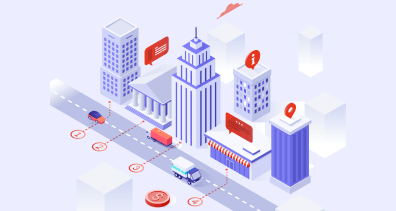
April 17, 2024

7 Min Read
Explore The Future Of The Construction Industry
Introduction
The construction industry is on the cusp of a revolution driven by a convergence of technological innovations and evolving trends. This blog will explore the current mechanisms shaping the construction industry, their benefits, and how artificial intelligence (AI) enhances the construction world. We will also highlight how platforms like Brickow support construction projects in this dynamic landscape.

Current Mechanisms in the Construction Industry:
Technological advancements are indeed revolutionizing traditional construction methods. It's incredible to see how new technologies enhance efficiency, safety, and sustainability in the construction industry. The construction industry is being transformed by technological advancements, leading to more efficient, safe, and sustainable methods.
Technological Advancements in Construction:
- Revolutionizing traditional methods: Technological advancements in construction are disrupting traditional methods that have been in place for decades. New technologies such as Building Information Modeling (BIM), prefabrication, drones, and robotics are transforming how construction projects are planned, designed, and executed. For example, BIM enables architects, engineers, and contractors to collaborate more effectively by creating a digital representation of the building or infrastructure project. This digital model contains detailed information about every aspect of the project, allowing stakeholders to visualize the final product and identify potential issues before construction begins.
- Embracing innovation for enhanced efficiency:The construction industry is increasingly embracing innovation to improve efficiency across all stages of the project lifecycle. From project planning and design to construction and maintenance, innovative technologies are streamlining processes and reducing project timelines. For instance, construction firms are adopting advanced construction management software that integrates project scheduling, budgeting, and resource allocation. These software solutions leverage data analytics and automation to optimize workflows, minimize delays, and maximize productivity on construction sites.
Overall, technological advancements in construction are revolutionizing traditional methods and driving innovation to enhance efficiency, productivity, and sustainability in the industry. By embracing these innovations, construction firms can stay competitive in a rapidly evolving market and deliver projects more effectively to meet the needs of their clients.
What is BIM?
BIM (Building Information Modeling) is a process that involves creating and managing digital representations of the physical and functional characteristics of places. It's not just about creating 3D models; it's about integrating all relevant information about a building or infrastructure project into a single digital model. This information includes geometry, spatial relationships, geographic information, quantities, material properties, cost estimates, and more.
One of the key aspects of BIM is its ability to facilitate collaboration among various stakeholders involved in the lifecycle of a construction project, including architects, engineers, contractors, and facility managers. By working with a shared digital model, these stakeholders can better coordinate their efforts, identify potential conflicts or issues early in the process, and make more informed decisions.
BIM offers several benefits to the construction industry, including improved visualization, enhanced coordination, better communication, reduced errors and rework, cost savings, and more sustainable building practices. As technology continues to advance, BIM is expected to play an increasingly important role in the way buildings and infrastructure are designed, constructed, and managed.
Benefits of BIM:
- Facilitates seamless collaboration among stakeholders: BIM acts as a central hub where architects, engineers, contractors, and other stakeholders can collaborate in real-time. By sharing a unified digital model, everyone involved can access and contribute to the project's progress, leading to smoother workflows and reduced miscommunication.
- Results in improved coordination: With BIM, coordination between different project elements becomes more streamlined. From architectural design to structural engineering and MEP (Mechanical, Electrical, Plumbing) systems, BIM ensures that all aspects of the construction align seamlessly, minimizing clashes and errors during the construction phase.
Impact on the Construction Industry:
- Transforming how projects are executed: BIM fundamentally changes the way construction projects are conceptualized, planned, and executed. By providing a comprehensive digital representation of the building or infrastructure, BIM enables stakeholders to visualize the project before construction begins, anticipate challenges, and make informed decisions throughout the lifecycle of the project.
- Promoting sustainability and efficiency: BIM contributes to sustainable construction practices by optimizing resource utilization, reducing waste, and enhancing energy efficiency. Through accurate simulations and analysis, BIM helps identify opportunities for sustainable design, such as passive heating and cooling strategies, green materials selection, and renewable energy integration.
Future Outlook:
- Continued integration of technology: The future of BIM lies in its integration with other emerging technologies such as artificial intelligence (AI), machine learning, and Internet of Things (IoT). This integration will further enhance BIM's capabilities, allowing for more advanced simulations, predictive analytics, and automated decision-making processes.
- Shaping a more innovative and sustainable construction landscape: As BIM becomes more ingrained in construction practices, it will play a pivotal role in shaping a more innovative and sustainable construction industry. By enabling better collaboration, optimization, and risk management, BIM will drive the adoption of sustainable building practices and pave the way for smarter, more resilient infrastructure for future generations.
AI's Impact on Construction:
- Data-Driven Decision-Making:AI enables data analysis for informed decision-making and enhancing project strategies.
- Predictive Analytics: AI predicts potential issues, allowing proactive problem-solving and risk mitigation.
- Robots and Self-Operating Machines: Robots and Self-Operating Machine tools increase on-site efficiency and productivity while reducing labor costs.
- Resource Optimization: AI optimizes resource allocation, leading to cost savings and improved outcomes.
Five advantages of mechanisms in the construction industry:
- Increased Efficiency: Mechanized construction equipment enables tasks to be completed more quickly and precisely than manual labor alone, leading to overall project efficiency improvements.
- Enhanced Safety: Mechanisms such as automated machinery and robotic systems can reduce the risk of accidents and injuries by minimizing direct human involvement in hazardous construction activities.
- Higher Productivity: Mechanized equipment allows construction projects to be completed in less time, resulting in increased productivity and the ability to take on more projects or meet tighter deadlines.
- Improved Quality: Mechanized construction processes often result in higher-quality outcomes due to the precision and consistency provided by automated systems, reducing errors and rework.
- Cost Savings in the Long Run: While initial investment costs can be high, mechanized construction equipment can lead to long-term cost savings through increased efficiency, reduced labor requirements, and minimized material waste.
Five Disadvantages of Mechanisms in the Construction Industry:
- High Initial Investment: Acquiring mechanized construction equipment requires a significant upfront investment, which can be a barrier for smaller construction companies or projects with limited budgets.
- Maintenance Costs: Mechanized equipment, such as heavy machinery, demands regular maintenance to ensure proper functioning and longevity. These maintenance costs can accumulate over time, especially for older equipment or in harsh working conditions.
- Skill Requirement: Operating sophisticated machinery often requires specialized skills and training. Not all construction workers may possess the necessary expertise, potentially leading to a shortage of qualified operators.
- Environmental Impact: Some mechanized construction equipment, particularly older models, can be environmentally unfriendly due to emissions and fuel consumption. Additionally, the production and disposal of machinery can contribute to environmental degradation.
- Job Displacement: The increasing use of mechanized equipment may lead to job displacement for manual laborers, who are replaced by automated processes. This can have social and economic implications for communities reliant on traditional construction labor.
Advantages of AI in Construction:
- Enhanced Project Management: AI can analyze vast amounts of data to optimize project scheduling, resource allocation, and risk management. This leads to better project planning and execution, ultimately improving project outcomes and timelines.
- Predictive Maintenance: AI-enabled sensors can monitor the condition of construction equipment and infrastructure in real-time, predicting maintenance needs before breakdowns occur. This proactive approach reduces downtime, extends equipment lifespan, and lowers maintenance costs.
- Improved Safety: AI-powered systems can analyze site conditions and worker behavior to identify potential safety hazards and prevent accidents. This includes monitoring for compliance with safety protocols, detecting hazards such as unstable structures or hazardous materials, and issuing warnings to workers in real-time.
- Optimized Building Design: AI algorithms can analyze design parameters and constraints to generate optimized building designs that meet functional requirements while minimizing costs and environmental impact. This leads to more efficient use of resources and better-performing structures.
- Quality Control: AI can automate the inspection process by analyzing images, videos, and sensor data to detect defects, deviations from specifications, and construction errors. This improves quality control and ensures that projects meet regulatory standards and client expectations.
Disadvantage of AI in Construction:
- High Initial Investment: Implementing AI technology in construction requires a significant upfront investment in hardware, software, and training. This can be a barrier for smaller construction firms or projects with limited budgets.
- Complexity and Integration Challenges: Integrating AI systems into existing construction workflows and processes can be complex and time-consuming. It may require changes to organizational structure, workflows, and data management practices, as well as overcoming interoperability issues between different software platforms and systems.
- Data Privacy and Security Concerns: AI systems rely on large amounts of data, including sensitive information about projects, clients, and workers. Ensuring the privacy and security of this data, particularly in cloud-based systems, requires robust cybersecurity measures to prevent data breaches and unauthorized access.
- Dependency on Technology and Skills: AI systems require ongoing maintenance, updates, and technical support to ensure optimal performance. Construction firms may become dependent on technology vendors or external experts for these services, and there may be a shortage of workers with the necessary technical skills to operate and maintain AI systems.
- Ethical and Social Implications: AI raises ethical concerns related to job displacement, algorithmic bias, and the potential for misuse or abuse of AI-powered surveillance systems. Construction firms must consider the social and ethical implications of AI adoption and ensure that AI systems are used responsibly and ethically.
Five Key Factors Impacting Construction Projects:
- Economic Conditions: Fluctuations in interest rates, inflation, and overall economic growth significantly influence construction activity. Economic downturns can reduce investment in construction projects, while periods of growth can stimulate increased construction activity.
- Regulatory Environment: Compliance with zoning laws, building codes, environmental regulations, and safety standards is essential in construction.
"The construction industry stands at the forefront of a technological revolution, fueled by innovations like Building Information Modeling (BIM), robotics, and advanced construction management software."
Conclusion
The construction industry stands at the forefront of a technological revolution, fueled by innovations like Building Information Modeling (BIM), robotics, and advanced construction management software. These technological advancements are not only revolutionizing traditional methods but also reshaping the entire landscape of construction operations.
As we continue to witness the transformative power of technology in construction, it becomes evident that collaboration, efficiency, and sustainability are key pillars driving industry evolution. Technologies like BIM facilitate seamless collaboration among stakeholders, resulting in improved coordination and streamlined project execution. Moreover, the industry's future outlook emphasizes the continued integration of technology, promising a more innovative and sustainable construction landscape.
Platforms like Brickow play a crucial role in this evolution, connecting stakeholders, ensuring transparency and trust through blockchain technology, and fostering an environment for growth and innovation. By embracing these innovations and leveraging cutting-edge solutions, the construction industry can navigate the challenges of tomorrow while building a sustainable world for future generations. Together, we embark on a journey towards a more efficient, collaborative, and sustainable construction industry, powered by innovation and driven by a shared vision of progress.



